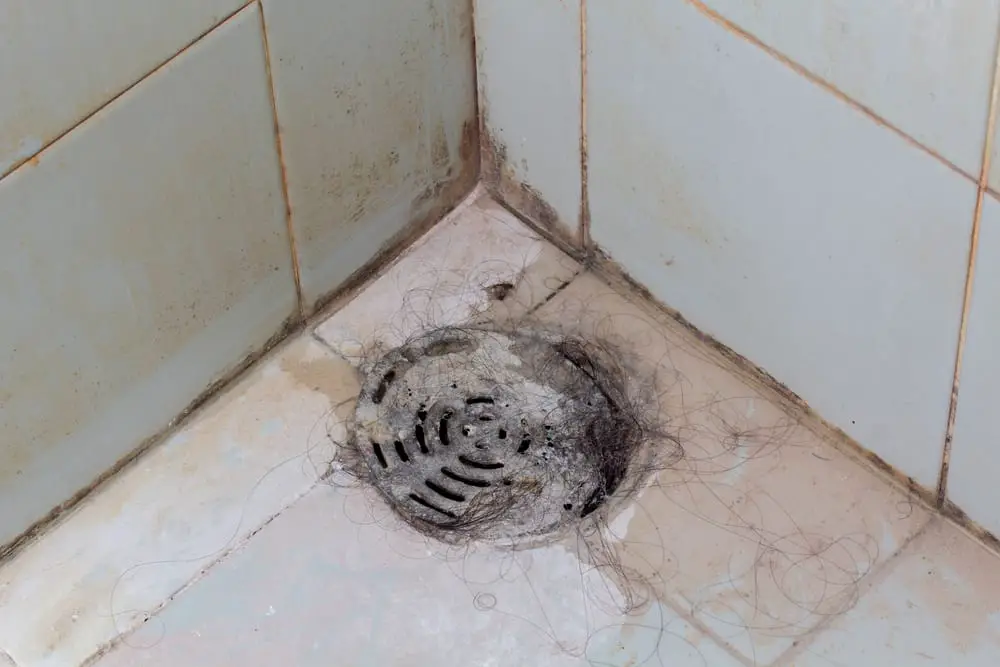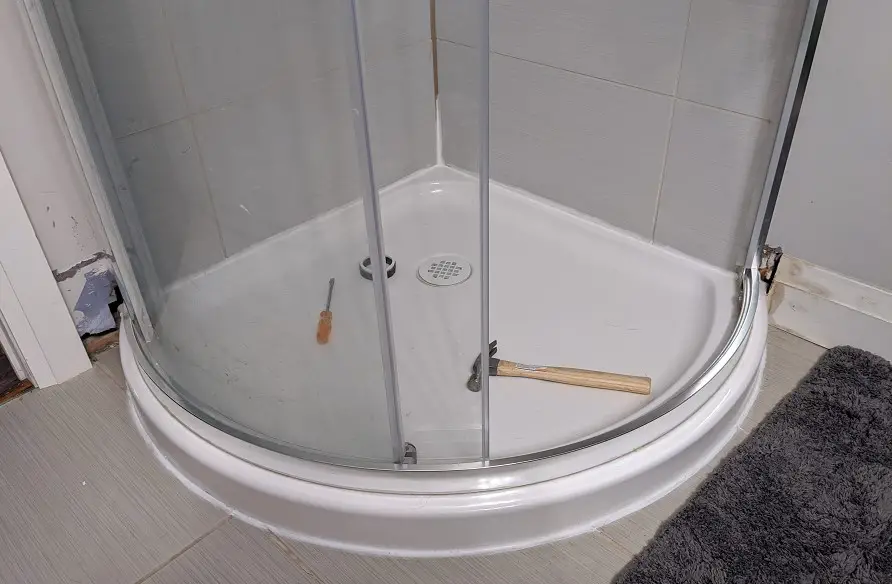A leaking shower drain can become a real headache for homeowners with basement bathrooms.
The resulting water damage can be difficult to repair and may even lead to mold growth and other health hazards. It is important to tackle the issue as soon as possible to prevent further damage.
In this article, we will discuss the causes of the P trap leak and solutions for dealing with basement shower drain leaking.

Contents
Causes of a leaking shower drain
A shower drain leaks can be due to several reasons. Here are some of the most common causes of shower leaking.
1. Damaged or worn-out gasket
A gasket is a rubber or silicone seal that prevents water from leaking through the connection between the shower drain pipes.
Over time, the rubber gaskets can become damaged or worn out, allowing water to leak through the gap.
When the rubber gasket is damaged, it can no longer create a tight seal in the shower drain pipe, allowing water to escape through the gap.
Damage to the rubber gasket can be caused by several factors, including aging, and exposure to harsh chemicals.
Additionally, fluctuations in temperature can cause the rubber gasket to expand and contract, leading to cracks and damage. You can replace it by using needle nose pliers or a putty knife.
2. Loose shower drain
If the shower drains are not firmly attached to the subfloor, they can move around when someone steps on them, causing the gasket to become loose or damaged.
This can also cause water to leak through the gap between shower drains. A loose shower drain pipe can be caused by several factors, including poor installation, age, and wear and tear.
3. Cracked shower pans
The shower pan is the waterproof membrane that lines the bottom of the shower. If the plastic shower pan itself is cracked or damaged, water can leak through and seep into the basement.
Shower pan cracks due to several factors, including age, poor installation, and wear and tear on plastic shower pans. Over time, it can become brittle and crack, leading to shower pan leaks.
4. Clogged drain
A clogged drain pipe can be a major headache for any homeowner. Not only does it prevent the proper flow of water, but it can also lead to water damage and costly repairs. Improper disposal of items such as grease or food waste can also contribute to clogs.
A P-trap is an important component of a drain that prevents sewer gas from entering the home. If the P-trap becomes clogged or damaged, it can lead to a leaking shower drain. This is because water can no longer flow properly through the drain, causing it to back up and leak out of the shower.
To prevent a leaking shower drain caused by a damaged P-trap, it is important to regularly clean your drain and inspect the P-trap for any signs of damage or wear and tear.
Additionally, it is important to ensure that the P-trap is properly installed and connected to the waste pipe to prevent leaks. If you suspect that your P-trap is damaged or clogged, it is important to address the issue as soon as possible to prevent further damage and health hazards.

Solutions for a leaking shower drain
If you are experiencing a leaking in a shower faucet, it is important to identify the cause of the problem. Once you have done so, you can proceed with the appropriate solution.
Here are some possible causes and the corresponding solutions.
1. Replace the gasket
If the gasket is damaged or worn out, it will need to be replaced. This is a relatively easy and inexpensive fix that can usually be done by a homeowner with a basic plumber’s putty.
To replace shower drain gasket remove the old gasket and install a new one in its place. When replacing the shower drain gasket, it is important to choose a high-quality gasket that is designed to withstand exposure to water and cleaning agents.
Additionally, it is important to ensure that the new gasket is installed correctly to create a tight seal between the front shower wall and drain and the waste pipe.
2. Tighten the shower drain
A leaky shower drain will need to be tightened to prevent it from moving around.
This may require removing the drain cover and tightening the screws that hold the drain in place.
Tightening the shower drain is a simple fix that can be done with a plumber’s putty.
When tightening the shower drain, it is important to ensure that the screws are tightened evenly to prevent the shower drain leaking.
3. Repair or replace the shower pan
If the shower pan is cracked or damaged, it will need to be repaired or replaced. This is a more complex and expensive fix that may require professional help.
Repairing a cracked shower pan involves filling the crack with a waterproof silicone sealant, or acrylic repair kit. If the crack in the damaged shower pan is too large, the shower pan may need to be replaced entirely.
When replacing a shower pan, it is important to choose a high-quality shower pan that is designed to withstand exposure to water and cleaning agents.
Additionally, it is important to ensure that the cover plate of the new pan is installed correctly to prevent leaks.
4. Clear the drain
If the drain flange is clogged, it will need to be cleared to prevent water from backing up and causing leaks. This can usually be done with a plunger or drain snake.
When clearing a clogged pipe or drain flange, it is important to use the right tool for the job. A plunger is effective for minor clogs, while a drain snake is more effective for larger clogs.
Additionally, it is important to avoid using harsh chemicals to clear the drain flange as this can damage the drain pipes.

Preventing future leaks
Preventing future shower faucet leaks is important to avoid further damage and costly repairs. Here are some tips to prevent a drain leaking into basement.
1. Regular maintenance
Regular maintenance of your shower faucet can help prevent leaks.
Here are some additional steps you can take to prevent shower drain leaks and ensure that the drain gasket stays in good condition:
- Use a drain cover to catch any hair or debris before it enters the drain.
- Pour a mixture of baking soda and vinegar down the drain once a month to help break down any buildup.
- Inspect the drain pipe for any signs of damage such as cracks or corrosion.
- Consider using a drain snake to remove any stubborn clogs.
2. Professional inspection
Having a professional inspect your shower and plumbing system regularly can provide several benefits. Not only can it help identify potential problems before they turn into major issues, but it can also help extend the lifespan of your plumbing system.
A professional plumber can inspect your P trap and drain leaks to identify any potential problems, such as a loose drain or a worn-out gasket.
3. Install a backup system
Installing a backup system is an essential step to fix a leaking shower drain pipe.
A sump pump or a backwater valve can be installed to ensure that water does not back up and flood your basement.
These systems are designed to provide maximum protection, even in the event of a clogged drain or other plumbing issues.
In addition to providing protection, backup systems are also easy to install and maintain. With the right system in place, you can have peace of mind knowing that your home is protected from water damage at all times.
4. Proper ventilation
Proper ventilation is crucial in maintaining a healthy and comfortable home environment. Not only does it help prevent water accumulation and mold growth, but it also improves indoor air quality by removing pollutants and stale air.
In addition to installing a bathroom exhaust fan or opening a window after showering, consider installing a whole-house ventilation system to ensure proper ventilation throughout your home.
This can greatly reduce the risk of respiratory problems and other health issues caused by poor indoor air quality.
Another way to improve ventilation is by using natural ventilation techniques, such as opening doors and windows strategically to create a cross-breeze.
5. Use a shower liner
A shower liner is a crucial component in any well-designed bathroom. By acting as a waterproof barrier, shower liners protect your shower pan and bathroom floor from water damage caused by leaks.
By preventing leaks, shower liners also help extend the lifespan of your shower pan by protecting it from water damage caused by cracks or other damage. Not only do ceramic shower pans and liners protect your bathroom from water damage, but they also come in a variety of stylish designs that can enhance the overall look and feel of your bathroom.
Whether you choose a classic white liner or a colorful, patterned liner, incorporating a shower liner into your bathroom design is a simple and effective way to upgrade your space.
6. Regular cleaning
Regular cleaning of your shower and drain can help prevent leaks and keep your bathroom clean and healthy.
It is important to clean your shower regularly to maintain its appearance and functionality.
In addition to cleaning the drain cover and removing any debris that may accumulate in the drain, you should also consider using specialized cleaning products to remove stubborn stains and soap scum buildup.
Furthermore, you can also prevent clogging by installing a hair catcher or using baking soda and vinegar to unclog your drain.
7. Use a drain strainer
A drain strainer is a simple device that can prevent debris, such as hair and soap scum, from going down the drain and causing clogs. By using a drain strainer, you can prevent clogs and keep your drain functioning properly.

FAQ
Why is my shower drain leaking to my basement?
A drain leaking into basement can be due to several reasons, such as a damaged or worn-out gasket, a loose shower drain, a cracked shower drain pan bottom, or a clogged shower drain. It is important to identify the cause of the leak and take the appropriate steps to prevent further damage.
Why is water leaking around the drain in my shower?
Drain leaking in a shower is due to a damaged or worn-out rubber gasket, a loose shower drain, or a cracked or broken shower pan itself. It is important to identify the cause of the leak and take the appropriate steps to prevent further damage.
Where does basement shower drain to?
A basement shower drain typically drains into the home’s main drain pipe, sewer line, or septic system of the house.
Is it normal to see water in the basement drain?
It is normal to see water in a basement drain, as this is the point where wastewater is directed out of the house. However, if you notice an excessive amount of water or water that smells bad, this may indicate a problem with your plumbing system and should be addressed as soon as possible.
Conclusion
In conclusion, shower leaking in your basement can lead to serious water damage and health hazards. It is important to address the issue as soon as possible to prevent further damage. By understanding the causes and solutions, you can take the necessary steps to fix a leaking shower and protect your home.
Regular maintenance, professional inspection, installation of a backup system, proper ventilation, use of a shower liner, regular cleaning, and use of a drain strainer can all help to prevent leaks and keep your basement dry and safe. Remember to always choose high-quality materials and seek professional help when necessary.
Read More: How to Find the Source of a Leaky Shower Drain or Pan


